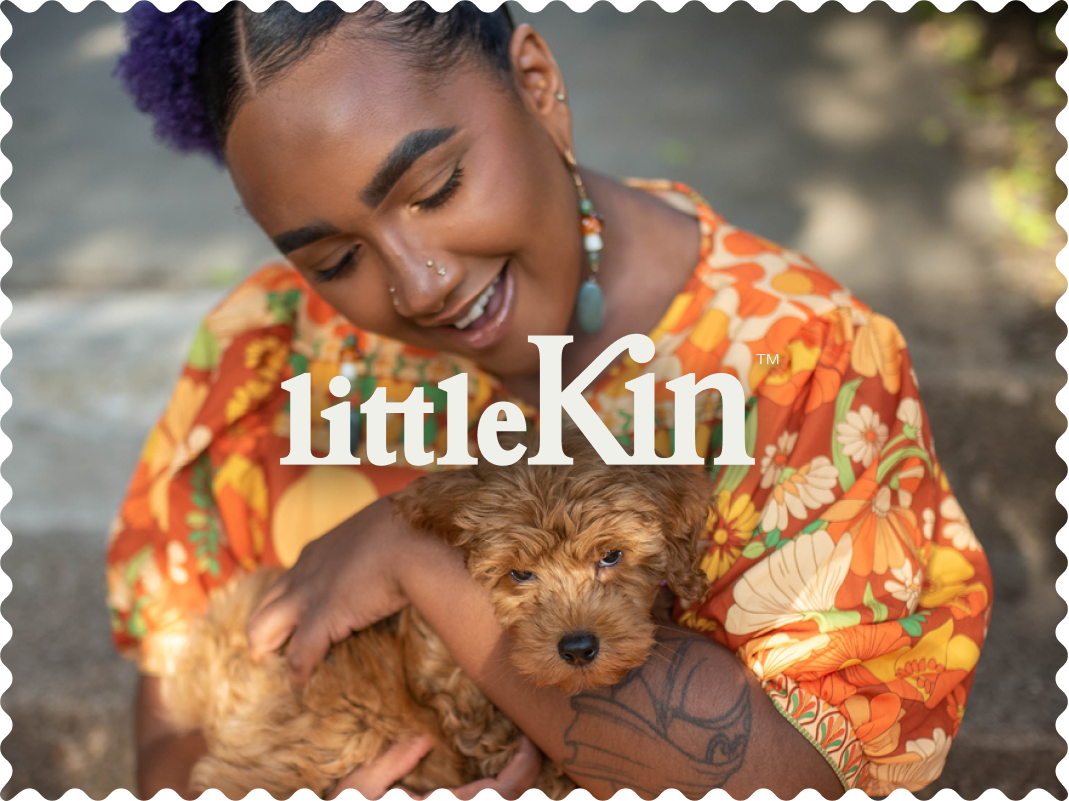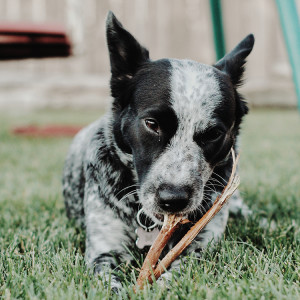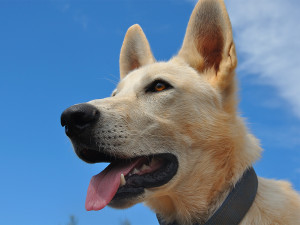Is Rawhide Bad for Dogs?
They’re everywhere in stores, after all.

Share Article
In This Article:
How Rawhide Is Made Rawhide Benefits Dangers of Rawhides for Dogs How To Safely Give Your Dog Rawhideopens in new tab Rawhide Alternatives Frequently Asked Questions
When you first bring a puppy or new dog home, one of the biggest challenges is to figure out what toys or treats you can get for them. First of all, which ones are actually safe for them? You just want something that’s going to occupy your pup’s time, but you also don’t want to get anything they’ll choke on.
So, here comes the big question: Are raw hide bones safe?
First, what is rawhide?
Rawhide is the inner layer of cow or horse hides. The outer layer is used for leather goods; after it is removed, the inner layer is cleaned for pet consumption. Popular chew treats for dogs are made from that inner layer. Rawhide is particularly valued for its tough, chewy texture, which can keep dogs chewing happily for long periods of time. You can find rawhide chews in many shapes and sizes. Some are even flavored with peanut butter, beef, or chicken to make your dog even more interested in them.

Rawhide is often labeled as a natural product but can vary widely depending on the processing procedure and where it is sourced. Rawhides are very popular with pet parents, but many veterinarians do not approve of them. Knowing how rawhide chews are made and why veterinarians don’t recommend them is important for helping you decide whether you want to give them to your pup.
How rawhide is made
The process of making rawhide involves several steps:
First, the outer layer of a cow or horse hide is stripped away, leaving the inner layer.
The hide is cleaned, either chemically or mechanically. This removes any remaining fat, tissues, or hair.
The hide must be preserved to prevent decay. This is done with chemicals like lime or bleach, but some manufacturers use more natural methods.
The hide is then cut into various shapes and sizes, knotted or rolled, and dried, creating a hard, chewy texture.
Some rawhide chews are coated or infused with flavors such as peanut butter, beef, or chicken to entice dogs while others are left plain.
Because the production process can vary greatly depending on the manufacturer and country of origin, the quality and safety of rawhide chews can also differ significantly.
Professional perspectives on rawhide
Veterinarians and pet nutritionists often have mixed opinions about rawhide chews. Some professionals like rawhide's attributes regarding mental stimulation and dental health. Others are concerned about safety and digestibility. Common professional concerns include:
Choking hazards: Large pieces can become lodged in a dog’s throat or intestines, causing choking or intestinal blockages.
Chemical residues: Depending on how the rawhide chews are produced, there may be harmful chemicals.
Digestive issues: Rawhide can be difficult for some dogs to digest, leading to GI issues such as vomiting or even obstruction.
Many veterinarians recommend watching your dog closely anytime your dog has a rawhide chew. They may also recommend that you only buy products with very few chemicals. Other professionals suggest you stay away from rawhides altogether and use safer chews made from dehydrated meat or dental chews.
Potential benefits of rawhide
In spite of the risks, there are benefits to offering rawhide to dogs:
Dental health: Chewing on rawhide can help decrease tartar buildup. This does not, however, replace the need for professional cleaning.
Mental stimulation: Dogs like to chew, and chewing rawhide can replace boredomopens in new tab and provide mental enrichment.
Behavioral benefits: Providing appropriate toys or chews for your dog may replace furniture chewing or digging.
Long-lasting entertainment: Rawhide tends to keep your dog busieropens in new tab for longer, which helps dogs with high energy or anxiety.
To maximize these benefits while minimizing risks, it’s important to:
Select high-quality, naturally processed rawhide from trusted manufacturers.
Keep an eye on your dog while chewing rawhide.
Purchase the correct size and shape for your dog’s chewing style.
7 dangers of rawhides for dogs
1. Rawhides are made with toxic chemicals.
While chews made from rawhide, bone, or other animal parts are consumable and are therefore considered “food” under Food and Drug Administration (FDA) law, as long as the label contains no reference to nutritional value (such as “high protein”), the agency advises that manufacturers “may not have to follow” the Association of American Feed Control Officials (AAFCO) pet food regulations.
Producing rawhide begins with splitting an animal hide, usually from cattle. The top grain is generally tanned and made into leather products, while the inner portion, in its “raw” state, goes to the dogs. Removing the hair from hides often involves a highly toxic recipe: sodium sulfide liming. Standard practice is to procure rawhide in the “split lime state” as byproducts from leather tanneries, facilities that top the list of U.S. Superfund sites.
Along the way, various chemicals are used to slow down the rate of decay of the animal skin. In the post-tannery stage, hides are washed and whitened using a hydrogen peroxide solution to get rid of the rotten stench. They may even be coated with titanium oxideopens in new tab to make them appear whiter. And that’s not all. Other poisonous residues that may show up in rawhide include lead, arsenic, mercury, and formaldehyde.
2. The flavorings may contain carcinogens.
Over the last decade, there has been an explosion of patents for flavored rawhide hitting the market, from bubble gum to hickory. However, these flavors are potentially more toxic. The more dogs lick, chew, and swallow the material, the greater their exposure to any contaminants it contains.
In the case of bubble-gum flavoring alone, the Material Safety Data Sheet revealed a toxic confection containing the carcinogen FD&C Red 40, along with preservatives like sodium benzoate. But tracking the effects of chemical exposure is nearly impossible when it’s a matter of slow, low-dose poisoning. The FDA’s veterinary branch, the Center for Veterinary Medicineopens in new tab, only checks into pet food additives after numerous complaints about a particular chemical.
3. Rawhides are not digestible.
Being a byproduct of the leather industry, traditional rawhides are chemically engineered to make them tough and durable, but those same qualities make them hazardous to a dog’s health. Rawhide chews are consumable, but that doesn’t necessarily mean they are digestible. “Most commonly, they swallow things that are too big to pass and end up stuck in the esophagus, stomach, or intestines,” says Dr. James Barr, assistant professor at the Texas A&M College of Veterinary Medicine & Biomedical Sciencesopens in new tab.
While a dog can happily chow down on a rawhide, softening it, they only break it into smaller chunks. Those tough non-digestible pieces are swallowed whole and do not break down. Instead, the rawhide swells within a dog’s stomach, making it difficult to pass. At best, rawhides can cause a minor stomach ache and, at worst, cause a life-threatening obstruction in the gut.
4. Dogs can choke on rawhide.
Another risk associated with rawhide is a dog biting off more than they can chew — literally. If a dog tries to swallow a chunk of rawhide that is too big, the piece may end up stuck in their esophagus, causing them to choke. And accidents can happen even if a pup properly chews their food before swallowing.
“The most common thing that causes actual choking in dogsopens in new tab are dog treats like rawhides that can be swallowed,” Dr. Barr says. Dogs who “want to quickly ingest their treats are the ones most likely to get things stuck in their throat. Though it’s too big to swallow, they try anyway.”
5. Teeth fractures are common.
While not exclusive to rawhides, chewing on hard objects, like rawhide, can cause significant tooth damage. According to Dr. Nadine Fiani, an associate clinical professor at Cornell University’s School of Veterinary Medicine, chewing on hard objects, like rawhide, is the most common cause of tooth fractures.
Puppies and aggressive chewers are more likely to experience a fracture because they lack inhibition. Not only can a fractured tooth be painful for pups, but it leaves the door open to a secondary infection, which can spread to other areas of the body.
6. There are grim connections to the dog-meat trade.
With rawhide produced in Asia, there’s no knowing what it’s made from. Even dog skin is a possibility. In some areas of Asia, the dog trade is widely prevalent, with tens of millions of dogs being slaughtered each year for their meat and fur.
An investigation in the late 1990s of the fur trade by Humane Society International resulted in this information: “In a particularly grisly twist, the skins of brutally slaughtered dogs in Thailand are mixed with other bits of skin to produce rawhide chew toys for pet dogs. Manufacturers told investigators that these chew toys are regularly exported to and sold in U.S. stores.”
7. There is a risk of blockages.
The most serious of the problems rawhide can cause is gastrointestinal blockages. If a dog swallows a large chunk of rawhide, it can become stuck in any part of the gastrointestinal tract, including the esophagus, stomach, or intestines. This can lead to vomiting, loss of appetite, abdominal pain, constipation, or even problems requiring emergency surgery. Blockages happen most often in small dogs, aggressive chewers, and dogs who gulp their food. This is why you always need to watch your dog when chewing rawhide.
Should you avoid rawhide completely?
It’s worth considering. Many veterinarians think you should. Particularly for dogs who chew aggressively or have a history of digestive problems, staying away from rawhide may be the right thing to do. Many veterinarians recommend considering alternative chews, like dental chews, rubber toys, or natural bones. If you do choose to allow rawhide, it must be given responsibly and with care.
How to safely give your dog rawhide
If, despite the risks, you decide you want to give your dog rawhide, note the following tips:
Watch your pup closely while they are chewing.
Choose pieces of rawhide large enough that your dog cannot swallow them whole.
Allow approximately 15 to 20 minutes of chewing time. This will prevent overeating.
Keep small or heavily chewed rawhide away from your dog.
Monitor for coughing, gagging, vomiting, or unusual bowel movements.
Before adding rawhide to your dog’s diet, talk to your veterinarian, especially if your dog has a history of GI issues.
By being watchful, you can significantly reduce any risk associated with rawhide.
How to choose the right rawhide for your dog
If you’re going to feed your pup rawhide, selecting the right product is important. Here’s what to look for:
Size and thickness: Pick a rawhide that's right for the size of your dog and chewing strength.
Origin and processing: Avoid chemically processed rawhides. Choose those made in the USA, where there are strict regulations.
Shape: Rolled or compressed rawhides are more difficult for a dog to break apart into dangerous chunks. They also last longer. Don’t get thin sheets.
Natural ingredients: The safest, healthiest rawhides are free from artificial preservatives, colors, or flavors.
Specialty products: If you have a dog who is prone to stomach issues, seek out more digestible rawhides.
By carefully choosing high-quality products and paying attention to your dog’s chewing style, rawhide can be made safer.
Healthy alternatives to rawhides
The most important thing to remember is to always supervise your dog while they’re chewing rawhide and remove any small pieces. For healthy alternatives to rawhide for your dog, consider using veggies such as carrotsopens in new tab, frozen kongsopens in new tab, free-range chews, bully sticksopens in new tab, Himalayan chews, or organic raw bones. If you do choose rawhides, look for those free of toxic preservatives and chemicals that are dried naturally and made in the USA.
Bottom line
Rawhide can be a controversial treat for dogs. On the one hand, it offers chewing satisfaction, helps with dental health by scraping away plaque, and can provide entertainment for hours. On the other hand, rawhide carries real risks including choking, digestive blockages, and contamination with chemicals during processing.
If you choose to give them rawhide:
Select high-quality, thick rawhides made without harmful chemicals.
Always supervise your dog while chewing.
Remove small or soft pieces before they can be swallowed.
When choosing treats, consider your dog's chewing style, age, and size.
For some dogs, safer alternatives like rubber toys, bully sticks, or digestible chews may be better.
FAQs
Is rawhide safe for puppies?
Rawhide is not recommended for puppiesopens in new tab, especially those under six months of age, due to the hazard of choking. Safer options for teething puppiesopens in new tab include puppy-specific teething rings, frozen carrots, or rubber chew toys designed for young dogs.
Is rawhide actually bad for dogs?
There are several dangers associated with feeding a puppy rawhide:
Poor-quality or chemically treated rawhides
Dogs who chew aggressively or gulp large pieces are at risk of choking or developing an intestinal blockage.
Lack of supervision during chewing. You should always watch your pup when they are chewing.
If you choose high-quality rawhide, supervise your dog, and limit chewing sessions, many dogs can enjoy rawhide safely.
What kinds of rawhides are safe for dogs?
The safest rawhides for dogs are single-ingredient rawhides with no added chemicals, colors, or preservatives. They should be thick, dense rawhides. A label that says “digestible” tends to be safer. Rawhides made in the USA, which has stricter regulations, are probably safer than those made abroad. Also, a rawhide that is rolled into sticks instead of sheets is safer for your dog.
What is the safest chew for dogs?
Safer chew options include rubber toys like KONGs, dental chews approved by the Veterinary Oral Health Council (VOHC), bully sticks (but monitor for swallowing risks), and dehydrated meat chews (such as single-ingredient tendons or ears). Always supervise your dog during chew time, regardless of the type of chew you provide.
What is an alternative to rawhide for dogs?
If you’re looking for rawhide alternatives, here are some healthier options:
Bully sticks (with caution)
Sweet potato chews
Yak cheese chews
Dental sticks
Rubber chew toys
Choosing an alternative that matches your dog’s size, breed, and chewing behavior can satisfy their natural need to chew while minimizing risks.
References
Arhant, Christine, et al. “Chewing Behaviour in Dogs – a Survey-Based Exploratory Study.” Applied Animal Behaviour Science, vol. 241, Aug. 2021, p. 105372, https://www.sciencedirect.com/science/article/pii/S0168159121001593?via%3Dihubopens in new tab
Hooda, S., et al. “In Vitro Digestibility of Expanded Pork Skin and Rawhide Chews, and Digestion and Metabolic Characteristics of Expanded Pork Skin Chews in Healthy Adult Dogs.” Journal of Animal Science, vol. 90, no. 12, 1 Dec. 2012, pp. 4355–4361, https://academic.oup.com/jas/article-abstract/90/12/4355/4717908?redirectedFrom=fulltextopens in new tab
Lage, Arthur, et al. “Effect of Chewing Rawhide and Cereal Biscuit on Removal of Dental Calculus in Dogs.” Journal of the American Veterinary Medical Association, vol. 197, no. 2, 15 July 1990, pp. 213–219, https://avmajournals.avma.org/view/journals/javma/197/2/javma.1990.197.02.213.xmlopens in new tab

Dr. Shelby Neely, DVM
Dr. Shelby Neely is a freelance writer and veterinarian who graduated from the University of Pennsylvania School of Veterinary Medicine and has practiced veterinary medicine for 30 years, specializing in small animals. Her work has appeared in Allivet, AsktheCatDoctor, WhiskerDocs, Ask the Cat Doctor Radio, Ask the Cat Doctor TV, and numerous other websites, brochures, newsletters, newspapers, and ebooks. In her spare time, Dr. Neely likes to spend time with her three children, two grandchildren, three cats, two grand-cats, and five grand-dogs.
Related articles
![Dog in the grass outside chewing on a bully stick]()
Chew on This: A Guide to Safe and Not-So-Safe Dog Bones
Two experts—a veterinary dentist and internist—rate the most popular dog bones.
![Happy dog with teeth visible, blue sky background]()
Does Your Dog Need a Dentist?
NYC’s top veterinary dentist on bad breath, dental disease, and brushing your dog’s teeth...daily.
Should I Give My Dog Antler Dog Chews?
There are some safety concerns you need to know.
![woman snuggling puppy while holding them]()
Can Puppies Have Bones?
And how to keep them safe while they chew.




